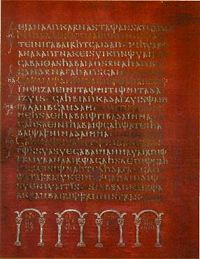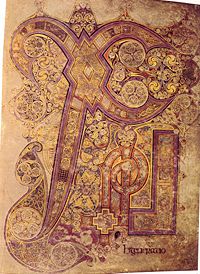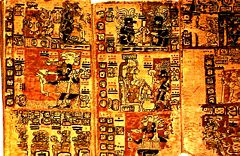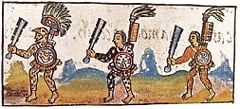Difference between revisions of "Codex" - New World Encyclopedia
Keisuke Noda (talk | contribs) |
Keisuke Noda (talk | contribs) |
||
| Line 8: | Line 8: | ||
and [[Ancient Greek|Greek]] {{lang|grc|-λογία}}, ''[[-logy|-logia]]'') is the study of books as physical objects, especially [[manuscript]]s written on parchment in [[codex]] form. It is often referred to as 'the archaeology of the book', concerning itself with the materials ([[parchment]], sometimes referred to as membrane or [[vellum]], [[paper]], pigments, inks and so on), and techniques used to make books, including their binding. | and [[Ancient Greek|Greek]] {{lang|grc|-λογία}}, ''[[-logy|-logia]]'') is the study of books as physical objects, especially [[manuscript]]s written on parchment in [[codex]] form. It is often referred to as 'the archaeology of the book', concerning itself with the materials ([[parchment]], sometimes referred to as membrane or [[vellum]], [[paper]], pigments, inks and so on), and techniques used to make books, including their binding. | ||
| − | Palaeography, | + | Palaeography,palæography ([[British English|British]]), or '''paleography''' ([[American English|American]]) (from the [[Ancient Greek|Greek]] {{lang|grc|παλαιός}} ''palaiós'', "old" and {{lang|grc|γράφειν}} ''graphein'', "to write") is the study of ancient [[handwriting]], and the practice of deciphering and reading historical manuscripts.<ref>'palaeography', ''[[Oxford English Dictionary]].</ref> |
[[New World]] codices were written as late as the 16th century (see [[Maya codices]] and [[Aztec codices]]). Those written before the Spanish conquests seem all to have been single long sheets folded [[concertina]]-style, sometimes written on both sides of the local [[amatl]] paper. So, strictly speaking they are not in codex format, but they more consistently have "Codex" in their usual names than do other types of manuscript. | [[New World]] codices were written as late as the 16th century (see [[Maya codices]] and [[Aztec codices]]). Those written before the Spanish conquests seem all to have been single long sheets folded [[concertina]]-style, sometimes written on both sides of the local [[amatl]] paper. So, strictly speaking they are not in codex format, but they more consistently have "Codex" in their usual names than do other types of manuscript. | ||
Revision as of 02:39, 8 October 2008
A codex (Latin for block of wood, book; plural codices) is a book in the format used for modern books, with separate pages normally bound together and given a cover. Although modern book is technically a codex, the term is used only for manuscripts. Codex was a Roman invention that replaced the scroll, which was the first form of book in all Eurasian cultures.
Overview
Although technically any modern paperback is a codex, the term is used only for manuscript (hand-written) books, produced from Late Antiquity through the Middle Ages. The scholarly study of manuscripts from the point of view of the bookmaking craft is called codicology. The study of ancient documents in general is called paleography.
Codicology (from Latin cōdex, genitive cōdicis, "notebook, book"; and Greek -λογία, -logia) is the study of books as physical objects, especially manuscripts written on parchment in codex form. It is often referred to as 'the archaeology of the book', concerning itself with the materials (parchment, sometimes referred to as membrane or vellum, paper, pigments, inks and so on), and techniques used to make books, including their binding.
Palaeography,palæography (British), or paleography (American) (from the Greek παλαιός palaiós, "old" and γράφειν graphein, "to write") is the study of ancient handwriting, and the practice of deciphering and reading historical manuscripts.[1]
New World codices were written as late as the 16th century (see Maya codices and Aztec codices). Those written before the Spanish conquests seem all to have been single long sheets folded concertina-style, sometimes written on both sides of the local amatl paper. So, strictly speaking they are not in codex format, but they more consistently have "Codex" in their usual names than do other types of manuscript.
The codex was an improvement upon the scroll, which it gradually replaced, first in the West, and much later in Asia. The codex in turn became the printed book, for which the term is not used. In China books were already printed but only on one side of the paper, and there were intermediate stages, such as scrolls folded concertina-style and pasted together at the back.[2]
History
The basic form of the codex was invented in Pergamon in the third century B.C.E. Rivalry between the Pergamene and Alexandrian libraries had resulted in the suspension of papyrus exports from Egypt. In response the Pergamenes developed parchment from sheepskin; because of the much greater expense it was necessary to write on both sides of the page. The Romans used similar precursors made of reusable wax-covered tablets of wood for taking notes and other informal writings. The first recorded Roman use of the codex for literary works dates from the late first century AD, when Martial experimented with the format. At that time the scroll was the dominant medium for literary works and would remain dominant for secular works until the fourth century. Julius Caesar, traveling in Gaul, found it useful to fold his scrolls concertina-style for quicker reference, as the Chinese also later did. As far back as the early second century, there is evidence that the codex—usually of papyrus—was the preferred format among Christians: in the library of the Villa of the Papyri, Herculaneum (buried in AD 79), all the texts (Greek literature) are scrolls; in the Nag Hammadi "library," secreted about AD 390, all the texts (Gnostic Christian) are codices. The earliest surviving fragments from codices come from Egypt and are variously dated (always tentatively) towards the end of the first century or in the first half of the 2nd. This group includes the Rylands Library Papyrus P52, containing part of St John's Gospel, and perhaps dating from between 125 and 160.[3]
In Western culture the codex gradually replaced the scroll. From the fourth century, when the codex gained wide acceptance, to the Carolingian Renaissance in the eighth century, many works that were not converted from scroll to codex were lost to posterity. The codex was an improvement over the scroll in several ways. It could be opened flat at any page, allowing easier reading; the pages could be written on both recto and verso; and the codex, protected within its durable covers, was more compact and easier to transport.
The codex also made it easier to organize documents in a library because it had a stable spine on which the title of the book could be written. The spine could be used for the incipit, before the concept of a proper title was developed, during medieval times.
Although most early codices were made of papyrus, papyrus was fragile and supplies from Egypt, the only place where papyrus grew, became scanty; the more durable parchment and vellum gained favor, despite the cost.
The codices of pre-Columbian Mesoamerica had the same form as the European codex, but were instead made with long folded strips of either fig bark (amatl) or plant fibers, often with a layer of whitewash applied before writing.
In Asia, the scroll remained standard for far longer than in the West. The Jewish religion still retains the Torah scroll, at least for ceremonial use.

Related disciplines
Cordicology
There are no clear-cut definitions: some codicologists say that their field encompasses palaeography, the study of handwriting, while some palaeographers say that their field encompasses codicology. The study of written features such as marginalia, glosses, ownership inscriptions, etc. falls in both camps, as does the study of the physical aspects of decoration, which otherwise belongs to art history.
By a close examination of the physical attributes of a book, it is sometimes possible to establish the history and provenance of a book, or to match up long-separated elements originally from the same book. Palaeographers and codicologists may also study the history of libraries, manuscript-collecting and of book-cataloguing.
Palaeography
Palaeography, palæography (British), or paleography (American) (from the Greek παλαιός palaiós, "old" and γράφειν graphein, "to write") is the study of ancient handwriting, and the practice of deciphering and reading historical manuscripts.[4]
Palaeography can be an essential skill for historians and philologists, as it tackles two main difficulties. First, since the style of a single alphabet has evolved constantly it is necessary to know how to decipher its individual characters. Second, scribes often used many abbreviations, usually so that they could write more quickly, and sometimes to save space, so the palaeographer must know how to interpret them. Knowledge about individual letter-forms, ligatures, punctuation and abbreviations enables the palaeographer to read the text as its producer intended it to be read. The palaeographer must know the language of the text and the historical usage of various styles of handwriting. Knowledge of writing materials is also essential to the ancient study of handwriting and the identification of the periods in which they are written.[5] An important goal may be to assign the text a date and a place of origin: this is why the palaeographer must take into account the style and formation of the manuscript.[6]
The first time the term "palaeography" was used was perhaps in 1703 by Bernard de Montfaucon, a Benedictine monk. During the 19th century palaeography fully separated from the science of diplomatics. Wilhelm Wattenbach and Leopold Delisle greatly contributed to this separation with their studies of the relationship between the human hand and writing. Their efforts were mainly directed at reconstituting "the ductus"—the movement of the pen in forming the letter—and to establish a genealogy of writing based on the historical developments of its forms.[7]
Notes
- ↑ 'palaeography', Oxford English Dictionary.
- ↑ Colin Chinnery. International Dunhuang Project - Several intermediate Chinese bookbinding forms from the C10th, Retrieved October 8, 2008.
- ↑ Turner The Typology of the Early Codex, U Penn 1977, and Roberts & Skeat The Birth of the Codex (Oxford University 1983). From Robert A Kraft (see link): "A fragment of a Latin parchment codex of an otherwise unknown historical text dating to about 100 C.E. was also found at Oxyrhynchus (POx 30; see Roberts & Skeat 28). Papyrus fragments of a "Treatise of the Empirical School" dated by its editor to the centuries 1-2 C.E. is also attested in the Berlin collection (inv. # 9015, Pack\2 # 2355) - Turner, Typology # 389, and Roberts & Skeat 71, call it a "medical manual.""
- ↑ 'palaeography', Oxford English Dictionary.
- ↑ Robert P. Gwinn, "Paleography" in The Encyclopaedia Britannica, Micropaedia, Vol. IX, 1986, p. 78.
- ↑ Fernando De Lasala, Exercise of Latin Paleography (Gregorian University Rome, 2006) p. 7.
- ↑ R. Marichal, “Paleography” in New Encyclopaedia New York: Gale-Thomson, 2003 Vol.X, p. 773.
See also
- Aztec codices
- Book
- Maya codices
- Paper
- parchment
- Scroll
- vellum
ReferencesISBN links support NWE through referral fees
- K.C. Hanson, Catalogue of New Testament Papyri & Codices 2nd—10th Centuries
- David Diringer, The Book Before Printing: Ancient, Medieval and Oriental, Courier Dover Publications, New York 1982, ISBN 0486242439
- C.H. Roberts – T.C. Skeat, The Birth of the Codex, Oxford University Press, New York – Cambridge 1983.
- L.W. Hurtado, The Earliest Christian Artifacts: Manuscripts and Christian Origins, Cambridge 2006.
External links
All links retrieved October 8, 2008.
- Centre for the History of the Book
- The Codex and Canon Consciousness - Draft paper by Robert Kraft on the change from scroll to codex
- The Construction of the Codex In Classic- and Postclassic-Period Maya Civilization Maya Codex and Paper Making
- Encyclopaedia Romana: "Scroll and codex"
Credits
New World Encyclopedia writers and editors rewrote and completed the Wikipedia article in accordance with New World Encyclopedia standards. This article abides by terms of the Creative Commons CC-by-sa 3.0 License (CC-by-sa), which may be used and disseminated with proper attribution. Credit is due under the terms of this license that can reference both the New World Encyclopedia contributors and the selfless volunteer contributors of the Wikimedia Foundation. To cite this article click here for a list of acceptable citing formats.The history of earlier contributions by wikipedians is accessible to researchers here:
The history of this article since it was imported to New World Encyclopedia:
Note: Some restrictions may apply to use of individual images which are separately licensed.



